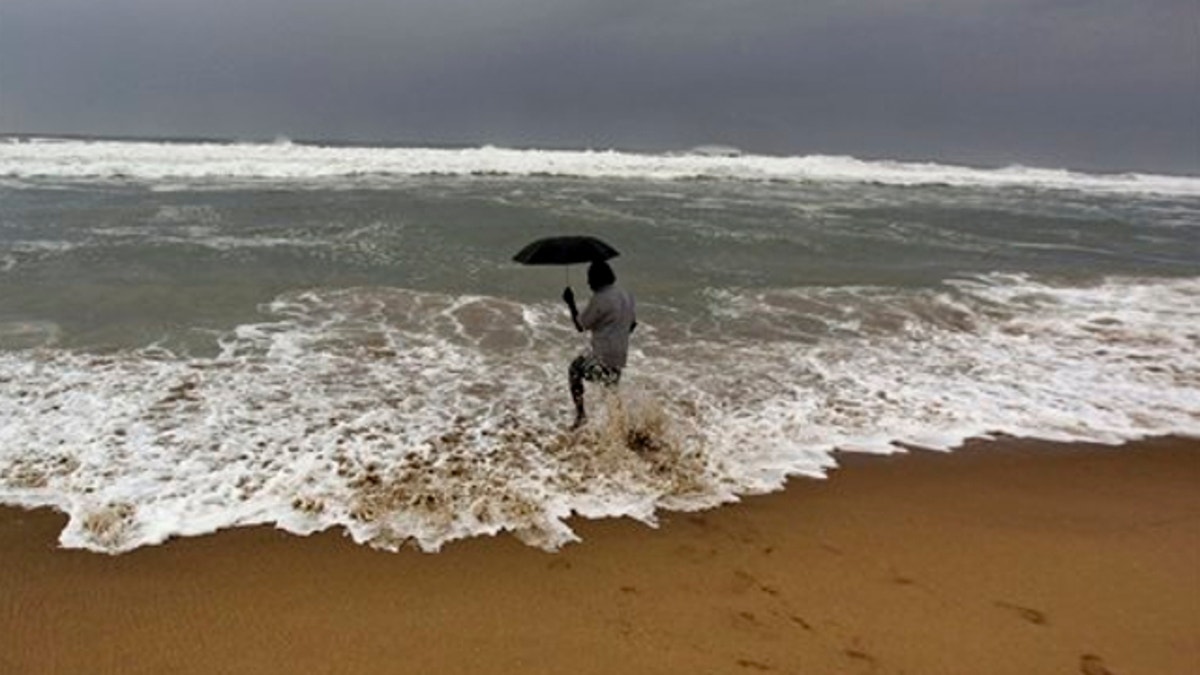
Oct. 11, 2013: An Indian man holds on to his umbrella as he fishes in high tide waves at Gopalpur beach, in Ganjam district, 136 miles away from the eastern Indian city of Bhubaneswar, India. (AP)
BHUBANESHWAR, India – A powerful cyclone tore into India's coast Saturday, reportedly killing at least five people and forcing tens of thousands into shelters as it snapped trees and electricity poles.
The Indian Metrological Department warned Cyclone Phailin was expected to remain a "very severe cyclonic storm," with winds of up to 130 mph into Sunday before weakening as it moves inland.
The U.S. Navy's Joint Typhoon Warning Center in Hawaii forecast maximum sustained winds of 167 miles per hour with gusts up to 196 miles per hour.
Rescue workers and soldiers were spread out across the region as they prepared to evaluate the full extent of the damage after daybreak Sunday, Reuters reported.
The skies were dark -- almost black -- at midmorning in Bhubaneshwar, the capital of Orissa state and about 60 miles from the coast. Roaring winds made palm trees sway wildly, and to the south, seawater was pushing inland.
About 12 hours before Cyclone Phailin's landfall, meteorologists held out hope that the storm might hit while in a temporary weakened state, but no matter what it will be large and deadly.
Ryan Maue, a meteorologist at Weather Bell, a private U.S. weather firm, said even in the best-case scenario there will be a storm surge of 20-30 feet.
A storm surge -- the giant wall of water that that a cyclone blasts ashore -- is the big killer in these storms, even more than winds.
Satellite images showed the cyclone filling nearly the entire Bay of Bengal, an area larger than France.
A storm this large can't peter out that fast," Maue said. "There's nothing to stop it at this point."
Officials canceled holy day celebrations and stockpiled emergency supplies in coastal Orissa and Andhra Pradesh states.
Indian officials also made less dire predictions about the storm surge, saying only it would be at least 10 feet high.
In Bhubaneshwar, government workers and volunteers were putting together hundreds of thousands of food packages to be distributed at relief camps.
The state's top official, Chief Minister Naveen Patnaik, appealed for people to cooperate with officials as they order people to leave their homes.
"I request everyone to not panic. Please assist the government. Everyone from the village to the state headquarters have been put on alert," he told reporters.
In Paradip, the Orissa port city hammered in a 1999 cyclone, at least seven ships had put to sea to ride out the storm, with other boats shifted to safer parts of the harbor, officials said.
U.S. forecasters repeatedly warned the storm would be immense.
"If it's not a record it's really, really close," University of Miami hurricane researcher Brian McNoldy told The Associated Press. "You really don't get storms stronger than this anywhere in the world ever. This is the top of the barrel."
To compare to killer U.S. storms, McNoldy said Phailin is near the size of 2005's Hurricane Katrina, which killed 1,200 people and caused devastating flooding in New Orleans, but Phailin also has the wind power of 1992's Hurricane Andrew, which had 165 mph winds at landfall in Miami.
The storm continues on its current path without weakening, it is expected to cause large-scale power and communications outages and shut down road and rail links, officials said. There would also be extensive damage to crops.
Using trucks and buses, authorities evacuated 40,000 people from 40 villages to government-run shelters, schools and buildings in five districts of Orissa, said Surya Narayan Patra, the state revenue and disaster management minister.
Patra said officials plan to take another 100,000 people to safer areas before the cyclone hits.
"No one will be allowed to stay in mud and thatched houses in the coastal areas," he said.
The government also began evacuating 64,000 people from the low-lying areas of three vulnerable districts in neighboring Andhra Pradesh state, said state Revenue Minister N. Raghuveera Reddy.
The sea had already pushed inland as much as 130 feet in parts of Andhra Pradesh.
Officials have been stockpiling emergency food supplies, and setting up shelters for people expected to flee the heavy winds and rains. The Indian air force said four transport planes and 18 helicopters were being kept ready for relief operations in the region.
What makes this storm so fearsome is that there's no wind shear to weaken it and the water that is fueling it is warm and deep, McNoldy said. Those are the ingredients for a record storm.
The Bay of Bengal has been the scene of some of the deadliest storms in recent history. The 1999 Orissa cyclone, which was similar in strength to Phailin, killed 10,000 people.
The Associated Press and Reuters contributed to this report.

